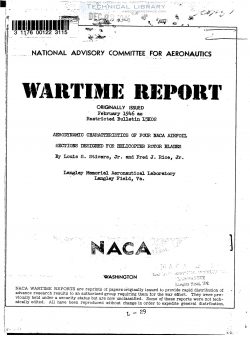naca-wr-l-29
- Version
- 98 Downloads
- 1.51 MB File Size
- 1 File Count
- April 15, 2017 Create Date
- April 15, 2017 Last Updated
Aerodynamic Characteristics of Four NACA Airfoil Sections Designed for Helicopter Rotor Blades

Four NASA airfoil sections, the NACA 7-H-12, 8-H-12,
9-H—12, and lO-H-la, suitable for use as rotor-blade
sections for helicopters and other rotary-wing aircraft
have been derived and tested. These airfoil sections
have comparatively low drags in the range of low and
moderate lifts and small pitching moments that are nearly
constant up to maximum lift. The undesirable adverse
changes in aerodynamic characteristics at higher lifts
and the undue sensitivity to roughness, which were found
for the airfoil sections reported in NACA CB No. 3115,
are minimized for the airfoil sections presented. A com-
parison of calculated profile-drag losses for a rotor
successively incorporating the NASA 5-H-13.5 (reported
in NACA GB No. Elli) and the 8-H—l2 airf01l sections
showed that the NACA C-H—la had smaller profile—drag
losses in nearly every operating condition presented.
From aerodynamic considerations, the NACA 8-H-12 and
9-H-i2 airfoil sections appeared more promising for use
as rotor-blade sections than any other airfoils thus far
tested at the NACA laboratories.
The desirable aerodynamic characteristics of airfoil
sections suitable for use as rotor—blade sections are:
(l) nearly zero pitching moments, (2) low drags through-
out the range of low and moderate lifts, and (3) moderate
drags at high lifts. With these characteristics in mind
several rotor-blade sections were derived with special
emphasis on obtaining high lift—drag ratios. These air-
foils, data for which are presented in reference 1, had
maximum lift-drag ratios nearly twice as large as those of
the NASA ZED-series airfoils at the same Reynolds number.
They showed, hOWever, some undesirable characteristics:
namely, sensitivity to roughness and abrupt adverse changes
in drag, lift-curve slope, and pitching moment in the
vicinity of the high-lift end of the range of low drags.
The purpose of the present work is to extend the
previous investigation and to derive additional airfoil
sections designed to minimize the undesirable character—
istics of the previously tested airfoils.
| File | Action |
|---|---|
| naca-wr-l-29 Aerodynamic Characteristics of Four NACA Airfoil Sections Designed for Helicopter Rotor Blades.pdf | Download |
Comment On This Post